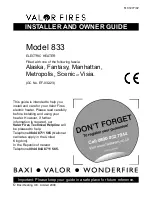
35
INSTALLATION INSTRUCTIONS
Venting
NOTICE:
To use 2-inch vent pipe, a
reducing adapter or bushing will be required.
Depending on the size of pipe that is chosen for
venting the water heater, it might be necessary
to use a fitting for stepping down in pipe size, to
connect to the water heater.
All intake and exhaust venting components
must have the same diameter size. Do not use a
different size on the intake and exhaust venting.
The unit may be vented horizontally through a
wall or vertically through the roof. Pipe runs must
be adequately supported along both vertical and
horizontal runs. Maximum unsupported span is
recommended to be no more than 4 feet (1.2 m).
It is imperative that the first hanger be located on
the horizontal runs immediately adjacent to the
first 90-degree elbow from the vertical rise. Only
use support isolation hanging bands. DO NOT use
wire to support pipe runs.
Stress levels in the pipe and fittings can be
significantly increased by improper installation.
If rigid pipe clamps are used to hold the pipe in
place, or if the pipe cannot move freely through a
wall penetration, the pipe may be directly stresses,
or high thermal stresses may be formed when the
pipe heats up and expands. Install accordingly to
minimize such stresses.
Preexisting Venting Notes:
If the water heater is being installed as a
replacement for an existing water heater, a thorough
inspection of the existing venting and air intake
system must be performed prior to any installation
work. Verify that the correct materials, vent lengths,
and terminal locations as described in this manual
have been met. Carefully inspect the entire venting
and air intake system for any signs of cracks or
fractures, particularly at the joints between elbows
or other fittings and the straight runs of vent pipe.
Check the system for signs of sagging or other
stresses in the joints as a result of misalignment
of any components in the system. If any of these
conditions are found, they must be corrected in
accordance with the venting instructions in this
manual before completing the installation and
putting the water heater into service.
NOTICES:
• It is recommended that the air intake and
exhaust pipes have a 1/4" per foot downward
slope toward the end of the pipes.
• Maintain the proper clearance between the
vent pipe and combustible or noncombustible
materials as described on page 29.
• Maintain a 0-in. (0-cm) minimum clearance
required between the air intake pipes and
combustible material.
• Use proper support for the vent and air intake
pipes.
• Support method used should isolate the
vent pipe from floor joists or other structural
members. This helps prevent transmission of
noise and vibration.
• Do not support, pin, or otherwise secure the
venting system in a way that restricts the normal
thermal expansion and contraction of the chosen
venting material.
See page 36 for additional requirements for the
Commonwealth of Massachusetts.


































